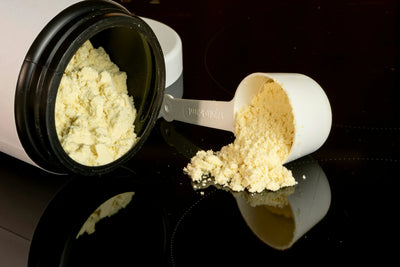Introduction
Many dogs are sensitive to certain food ingredients (e.g., beef, chicken, dairy, etc.), which may trigger symptoms such as itchy skin, vomiting, or diarrhea. The diagnosis of a food allergy usually needs to be made by elimination.
Environmental factors such as pollen, dust, and mold may also cause allergic reactions in dogs. Spring and fall are high allergy seasons, and dogs may experience symptoms such as a runny nose and sneezing.
Parasites such as fleas and ticks not only bite your dog directly, but may also trigger an allergic reaction. Certain components of flea saliva, in particular, can often lead to serious dog dermatitis.

Symptoms of Allergies in Dogs
Dog allergies have a wide variety of symptoms, and knowing these symptoms will help you recognize the problem and take action in a timely manner.
1. Skin symptoms: The most common symptom is itchy skin. Dogs may keep scratching and licking, resulting in redness, swelling, hair loss and even infection.
2. Respiratory symptoms: Dogs may experience respiratory symptoms such as runny nose, sneezing, coughing, etc., especially when exposed to allergens.
3. Digestive symptoms: certain food allergies may lead to vomiting, diarrhea and other indigestion symptoms.
4. Systemic symptoms: In severe cases, dogs may develop systemic allergic reactions, such as facial swelling and shortness of breath, requiring immediate medical attention.
Recognizing these symptoms in time can help the owner take quicker action.
Common Skin Allergies Problems
1. Allergy
Like us humans, dogs can be allergic to a wide variety of pollens or other environmental factors. It can occur from breathing in allergens or from skin contact. Identifying allergens can be a difficult task and may require injections or medications to control your dog's allergy symptoms.
Flea bites do cause itchy symptoms, but some dogs are so allergic to flea bites that they will scratch and lick and bite even if it's just a single bite. Cleaning fleas from your home and your dog's body can be a hassle, but if you can get rid of the fleas, then his itchy allergy symptoms should be eliminated.
Pets have been fed specialized grains for decades and there are some dogs that develop some allergies to ingredients or even common proteins like beef or chicken. The only way to diagnose food allergies is through a food exclusion diet. Once you have determined which ingredients are the culprits of your dog's allergies, you will have to eliminate the use of that ingredient in the future to provide for your dog's health.
2. Eczema
Manifests as red, swollen skin that may feel hot when you touch it. Eczema can appear anywhere, but it often develops on the chest, buttocks or head, and can be caused by allergies, insect bites, infections and dogs licking that area too often. Eczema is best treated even if you go to the vet in order to make sure that your dog is getting the best treatment possible, it is one thing to be able to treat eczema but if the cause of these symptoms is not found then the skin condition will keep recurring.
3、Granuloma Due to Licking and Biting
This is a skin irritation caused by excessive licking and biting, usually on the front legs, where he loses hair and affects every layer of skin. It is usually accompanied by a bacterial or yeast infection. The skin can be so damaged that under a microscope you can even see clusters of bacteria, destroyed hair follicles, clogged and oil glands, dilated and inflamed capillaries. Often it may look like eczema, but unlike eczema, he is a chronic condition and even if it passes treatment, he will remain there as long as the dog keeps licking.
4、Mange
Mange and helminthic mites, they are both caused by mites, which are tiny extracorporeal parasites that may cause symptoms of infection when they colonize on top of your dog's skin or fur. This disease is easily spread from dog to dog. Infected dogs will scratch incessantly, causing bald spots, inflammation, mange scars and scabs. Mange usually starts on the face, ears or legs, but may spread throughout the body.
5. Mites
Mites can and will spread to people, but usually the mites don't survive and we don't get infected. If your dog appears to have mange, then he should be taken to the vet promptly so that you can be sure that your dog is receiving the best possible treatment. And because mange is caused by parasites, you should replace infected bedding, carpets and collars to prevent the disease from returning.
6. Bacterial dermatitis
The most common of the curable skin diseases is recurrent bacterial dermatitis, in which the dog develops round bald patches, flaking and crusting, as well as tiny inflamed rashes that can evolve into more crusty patches. Bacterial dermatitis rarely occurs in the average healthy dog, so it's important to consider what potential triggers there are for dermatitis.
7. Yeast infection
Yeast is a common skin infection that usually appears around the ears and paws. Dogs will paw at their ears or bite their feet. The skin is also often irritated and discolored and may be greasy and smelly. It can be treated with medicated baths or ointments as well as internal medications.
8. Moss
Moss is actually a fungus, not a parasite or anything like that, although it does have similar symptoms to mite onset: round bald, scaly flaky, red, swollen skin patches. Moss can be transmitted from dog to dog through close contact, and is more common in puppies. It can also be treated with medicated baths, ointments or internal medications.
9. Cushing's disease
This disease itself is not a skin disease, it is caused by adrenaline to produce too much cortisol and lead to many skin problems as a disease. Cushing's disease has no cure for the time being, but there are many treatments that can improve your dog's skin problems for a short time.
10. Hypothyroidism
Hypothyroidism is a condition that occurs when the thyroid hormone is not secreted enough, such as when a dog has weight gain or obesity problems, and has hair loss and skin problems. Hypothyroidism is easily diagnosed with a blood test that checks the levels of thyroid hormones. Most dogs with hypothyroidism respond well to treatment with synthetic thyroid medications. However, most dogs suffer from hypothyroidism without treatment, and if your dog has chronic recurring skin problems or unexplained weight gain, then your dog may have hypothyroidism.

11. Dryness
Yes, dogs can suffer from dry skin just like people. Dry skin is one of the most common skin problems in dogs, and you can look for scaly or flaky skin, or signs of redness and inflammation by ruffling the fur.
There are many causes of dry skin syndrome, including:
Environment: dry skin is more common to occur in areas with low humidity, or during the dry fall and winter seasons
Allergies: to shampoos, perfumes, smoking, or other allergens can cause dry skin in dogs.
Dehydration: If your dog doesn't get enough water throughout the day, his skin may begin to show signs of dryness. Make sure your dog gets enough water throughout the day, and be prepared to replenish it when he's outside for long periods of time.
Dietary Issues: Although too much fat intake in dogs can lead to some health problems, a lack of healthy fat intake can lead to dry skin. There are some pet food on the market that will add some healthy oils that are good for the skin coat. Dogs with dry or dull skin can stay healthy by consuming the right amount of supplements.
Best Dog Food for Dogs with Skin Allergies
What is the best food for dogs that are prone to skin allergies, scratching and redness, or skin conditions such as rashes? Switching to natural fresh foods can help, but there are many different types of skin conditions in dogs, and most of them can't be solved with a single nutrient, just as our bodies need a variety of balanced nutrients to support each other. Nutrients related to skin health include vitamins A, B2, B3, B5, B6, and E, which can be obtained from fresh food, as well as environmental irritants, emotional stress, and lifestyle habits that can affect skin health. We have summarized the seven dietary principles that apply to both dogs and cats!
1. Avoid additives and over-processed foods
This is why some dogs and cats experience a natural improvement in their skin condition after switching to fresh food. Over-processed food and additives can have adverse effects on the skin, intestines, liver and kidneys. On the contrary, choosing natural and unadulterated fresh food, cooking moderately and reducing the processing procedures to avoid destroying nutrients and killing disease-causing bacteria and spores, you can definitely eat a healthy and safe diet.
2. Supplement Omega-3 unsaturated fatty acids
Omega-3 is a kind of polyunsaturated fatty acid, because with another kind of fatty acid is easy to imbalance in the diet, resulting in the body's inflammatory reaction, and most of the skin diseases, including allergies, redness and swelling are a kind of inflammatory reaction, so it is recommended to consume more Omega-3. Omega-3 rich foods include fish and shellfish, flaxseeds, but dogs and cats are poor in the utilization of plant-based sources of Omega-3, you can also directly supplement fish oil. Omega-3 rich foods include fish, shellfish, and flaxseed, but dogs and cats utilize plant-based Omega-3 sources poorly.
3. Supplement with Probiotics
The intestinal tract is the largest immune organ in the body, and immune responses such as allergies and inflammation can be regulated by a healthy intestinal tract. To maintain intestinal health, it is effective to increase the number of good bacteria in the intestines to balance the quality of the flora. In addition, consuming the right amount of dietary fiber can also prolong the life of good bacteria in the intestines, so you can supplement Astragalus polysaccharide, oligosaccharides and other supplements. With a healthy gut, the ability to absorb nutrients increases, and the benefits are numerous.
4. Eat more food that clears heat and relieves dampness
Excessive dampness can also easily lead to skin problems. If coupled with a hot and dry body, the accumulation of dampness in the body can not be discharged, which can easily lead to skin rashes, redness, swelling and hair loss. If this is the case, you can supplement the heat and dampness food, such as: barley, mung beans, cornhusk, etc., can be added directly to the food, or boiled water to drink, are summer can help ease the heat and dampness of the ingredients.
5. Choose high quality protein
There are proteins in many ingredients, but only proteins with complete amino acid composition and good digestion and absorption can be called high-quality proteins. Protein is the main structure of cells, and is needed for the growth of skin, muscles, and hair. Therefore, choosing more high-quality protein sources, such as lean meat, fish, and eggs, is not only good for skin health, but also good for strengthening the immune system and reducing the burden on the kidneys.
6. Avoid allergens
If the skin condition is determined to be caused by allergies, then avoiding allergens is very important. Some people simply know that their dogs or cats are allergic and avoid all foods that may cause allergies, which in turn results in an overly restrictive and biased diet. Another way is to take your pet to the hospital for allergen testing to find out what your pet is allergic to and then choose the right food for your pet.
How to Treat Flea Allergy Dermatitis in Dogs at Home?
1. Recommendations for Effective Medications
When dealing with dog allergies, choosing the right medication is crucial. Below are some common recommendations for effective medications:
- Antihistamines: such as Chlorpheniramine and Cetirizine can effectively relieve itching and allergic reactions in dogs. These medications usually have fewer side effects, but it is best to consult your veterinarian before use.
- Steroid medications: such as Prednisone, which is indicated for severe allergic reactions and can quickly reduce inflammation and itching. Prolonged use may lead to side effects and should be used under the supervision of a veterinarian.
- Immunosuppressants: Cyclosporine is suitable for the treatment of persistent allergies and can effectively suppress the immune response and reduce the symptoms of allergies. These drugs are expensive and should be used with caution.
- Topical therapeutic drugs: such as topical ointment containing Fluocinolone, which can act directly on the affected area to relieve itching and inflammation, and is suitable for mild allergy symptoms.
When choosing medication, owners need to choose the most appropriate option according to their dog's specific situation, combined with the advice of their veterinarian.
2. Dietary Adjustments
- Hypoallergenic Prescription Food: Choose hypoallergenic prescription food for your dog, which are usually free of common allergens such as beef, chicken, and wheat. Hypoallergenic prescription foods help reduce allergic reactions in dogs and promote skin health.
- Hypoallergenic Meat: In addition to prescription food, you can also choose hypoallergenic meats for your dog's food, such as rabbit. These meats are hypoallergenic and less likely to cause allergic reactions in dogs.
- Avoid allergens: In your dog's diet, try to avoid foods that contain known allergens. If your dog is allergic to a certain food, stop feeding that food immediately and observe if your dog's allergy symptoms improve.
3. Analysis of Precautions
Here are a few things to keep in mind when administering allergy medication to your dog:
Different dogs may react differently to the medication, so it is best to consult a professional veterinarian for advice before using any medication to ensure safety and effectiveness.
After using the medication, you need to closely observe your dog's reaction, and stop the medication and seek medical attention if any abnormal symptoms appear. Common side effects include lethargy and loss of appetite.
Although there is a lot of information about dog allergies on the Internet, each dog's condition is unique and owners should not judge and administer medication on their own to avoid unnecessary harm.
A reasonable diet is also very important in drug treatment. Avoid giving your dog food that may cause allergies and choose hypoallergenic dog food to help reduce symptoms.
For dogs that are prone to allergies, regular health checkups and skin tests can help identify allergens in time and take appropriate measures.

4. Ways to Prevent Allergies in Dogs
Preventing dog allergies is an effective way to reduce their suffering, here are some practical preventive measures:
Clean your dog's living environment regularly to reduce the accumulation of dust and allergens, especially during the change of seasons, and keep the indoor air circulating.
Bathing your dog appropriately and using mild pet bathing products can help remove allergens from the skin and keep it healthy.
Choose high-quality dog food, avoid food containing artificial additives and common allergic ingredients, and regularly observe your dog's dietary reactions.
Deworm your dog regularly to prevent allergic reactions caused by parasites and keep your dog healthy.
Keeping your dog physically active will help strengthen the immune system and reduce the chances of allergies occurring.
With these preventive measures, owners can effectively reduce the incidence of dog allergies and provide them with a healthier living environment.
In conclusion, when your dog develops allergy symptoms, seek medical attention and follow your vet's recommendations for treatment and care. When it comes to diet, it is important to choose hypoallergenic foods and avoid foods that contain allergens to promote your dog's healthy recovery.





